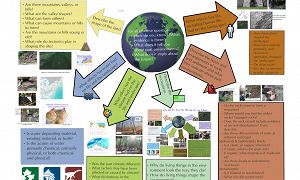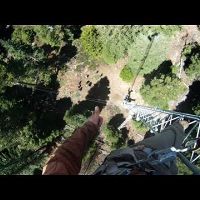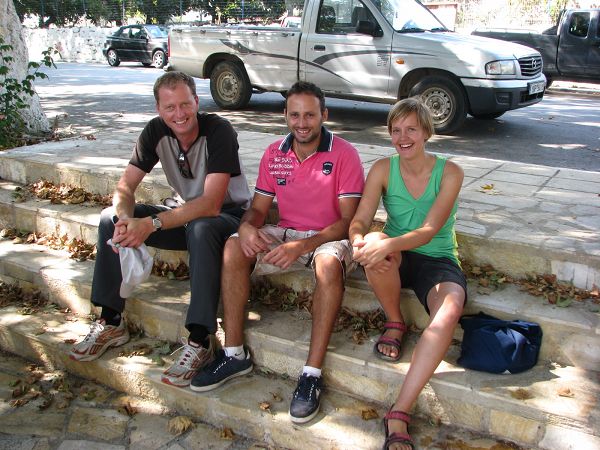Higher Education
The development of a new scientific discipline requires focused education of young scientists engaged in the new discipline
Faculty, staff, graduate student and post-doctoral researchers from all of the U.S. and SoilTrEC CZOs mingle along a roadside in the White Mountains of Crete during a joint meeting and field trip hosted by the Technical University of Crete and Koiliaris CZO during September 2008.
Educational Resources (examples for Higher Education)
- Interpret the environment represented within the VFE you are investigating, including descriptions of why the landscape looks the way it does, and how it has changed over time.
- Create a VFE representing your local environment or a field site you have visited and present it to interested others.
- Describe how distribution of trees varies by species.
- Speculate what factors determine species' affinity for particular placement within the Shale Hills catchment.
- Design investigations to test hypotheses about species distribution.
- Describe similarities in the geographic distribution of different characteristics of the landscape.
- Speculate on relationships among these different characteristics.

Grades 3 - 14
Virtual Fieldwork in the Critical Zone
All Disciplines
Virtual Fieldwork • Activity • Curriculum • Lesson Plan • Computer Activity
This webpage serves as an introduction to both CZ science and the use of Virtual Fieldwork Experiences (VFEs) for exploration of the CZ. Embedded within this page you will find VFEs of Shale Hills Susquehanna, Southern Sierra CZO and Luquillo CZOs.
Educational Objectives
Objectives for specific VFEs are included within those VFEs.
Audience: K-12 • General Public • Higher Education
Observatory: National CZO • Luquillo CZO • Shale Hills CZO • Sierra CZO
Author: Don Haas (PRI), Alexandra Moore (PRI), Michelle Gilmore (SSCZO)

Grades 3 - 16
Shale Hills Tree Survey, Google Earth File
Biology/Ecology • GIS/RemoteSensing • SoilScience/Pedology
Virtual Fieldwork • Computer Activity • Demo • Dataset
This kmz file contains basic data on every large tree within the Shale Hills catchment, including species and Diameter at Breast Height (DBH). Explore the data and look for patterns of species distributions by clicking on and off different species. This file is included within the Shale Hills VFE.
Educational Objectives
The listed objectives are suggestive. Teachers may design activities using the dataset with their own objectives.
The survey can also serve as a model for surveying trees (or other elements) in your local environment.
Audience: K-12 • General Public • Higher Education
Observatory: National CZO • Shale Hills CZO
Author: Don Haas, Sarah Sharkey

Grades 6 - 14
Reynolds Creek Virtual Tour
Biogeochemistry • Biology/Ecology • Climatology/Meteorology • SoilScience/Pedology • Outreach/EducationResearch
Tour • Video • Website • Information
Take a virtual tour of the Reynolds Creek Critical Zone Observatory! Track snowfall and predict soil thickness. Learn about soil carbon and how climate change and sagebrush ecosystems are modeled.
Educational Objectives
Objectives being written.
Tracking Snow: Measuring Nature’s Water Reservoir.
Organic Carbon: The Key Variable in a Changing Climate.
Inorganic Carbon: A Different Type of Carbon.
Predicting Soil Thickness: Anywhere on a Landscape.
CORE Sites: The Most Advanced Ecosystem Measurements Anywhere.
Audience: K-12 • General Public • Higher Education
Observatory: Reynolds CZO
Author: Sindelar, H., Kanode, C., and S. Lanier. Montana State University. School of Film & Photography.
Funding: The Reynolds Creek Critical Zone Observatory: EAR # 1331872 and ICER # 1445246

Grades 6 - 14
Mapping Earth systems
All Disciplines
Information • Dataset • Activity
View ten maps of the contiguous 48 states, each highlighting different geographic features. Viewing the maps collectively reveals connections among different Earth systems.
Educational Objectives
NGSS Crosscutting Concepts: Patterns • Systems and System Models
NGSS Science & Engineering Practices: Developing and Using Models
NGSS Disciplinary Core Ideas: ESS2 - Earth’s Systems • ESS3 - Earth and Human Activity
Audience: K-12 • General Public • Higher Education
Observatory: National CZO
Author: Don Haas (PRI)
See more resources for Higher Education >
The most successful of these education activities has been the CZO International Scholars program. Through support from NSF-International Programs-Europe since 2007, 54 graduate students within and outside of the CZOs from 16 universities througout the United States have visited more than 20 European host institutions and field sites. In the process, the student travelers have broadened their scientific knowledge and perspective, availed of unique expertise and instrumentation not available in the U.S., and generated data sets to compare to information gathered from field sites and labs at or associated with the various U.S. CZOs. A compilation of abstracts and papers derived in whole or in part from this support is available under associated files (see below). The program will continue in 2015 through 2019 due to funds provided to the CZO National Office from an NSF Science Across Virtual Institutes grant.
A group of six CZO collaborators are currently working to develop a new undergraduate curriculum in Critical Zone science. Their effort is supported by the NSF-funded InTeGrate program and aims to develop a new semester-long course comprised of stand-alone, ~two-week long modules. The course has been fully developed and moved into the testing phase at 6 universites - in 2015 that course content will be available on the SERC website and here for anyone to use in their courses.
Tim White, as national coordinator, and Susan Gill, Stroud Water Research Center education director, developed a successful Research Experience for Undergraduates program that places 6 undergraduate students each at the Christina River Basin and Shale Hills CZOs during the summers of 2014 through 2016. The results of those REUs were presented at the 2014 biennial meeting of CUAHSI entitled Water Across the Critical Zone, and will soon be available for download here.
The higher education program has also been enriched by close CZO ties to its European counterpart, Soil Transformations in European Catchments (SoilTrEC), a research initiative that includes 4 CZOs in Europe. Each year SoilTrEC stages a variety of graduate student and post-doctoral research training workshops and meetings and graciously invites U.S. students and other participants, while the U.S. NSF has provided funds to support limited participation in some of those workshops. Most recently, 14 U.S. students, half from within and half from outside the formal CZO program, participated in a reactive transport modeling workshop held at the Technical University of Crete in July 2012.
U.S CZOs have also hosted European graduate students and post-doctoral researchers for training events. Here three graduates of the 2010 Critical Zone field school held at the Susquehanna-Shale Hills CZO, Georg Lair, Manos Kotronakis, and Taru Lehtinen, share a moment together in Crete at the annual meeting of SoilTrEC, October 2012.
Georg Lair, Manos Kotronakis, and Taru Lehtinen in Crete, October 2012.
Associated Files
Intlscholarspub
(88 KB pdf)
List of abstracts and publications derived from International Scholars funding provided by the US NSF.
News

Eos: Dust in the Wind: Human Impacts to the Colorado Front Range
04 Aug 2020 (Boulder) - Ruth Heindel (former BcCZO post-doc)’s paper was featured by the Journal of Geophysical Research: Earth Surface.

FEATURED
Southern Sierra CZO Videos
04 May 2020 (Sierra) - Onward California - University of California television spots showcase Southern Sierra CZO research

FEATURED
Graduate Student Critical Zone Reading Group Wraps the Semester with a Field Trip to Calhoun CZO
12 Jun 2019 (Calhoun, Shale Hills) - Five students travelled to Union, South Carolina for a two-day site visit June 6 – June 8 at the Calhoun CZO. This site visit was the...

Two week field experience kick-off for the 2019 GeoPATHs cohort
18 May 2019 (Shale Hills) - Fifteen undergraduates from seven regional institutions arrived at University Park, along with graduate student mentors and faculty experts, to...
Explore Further






